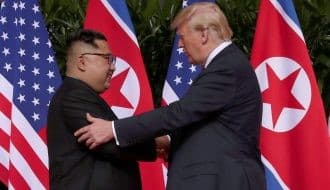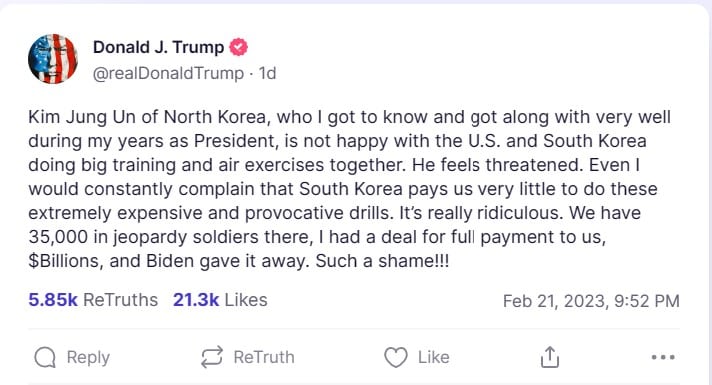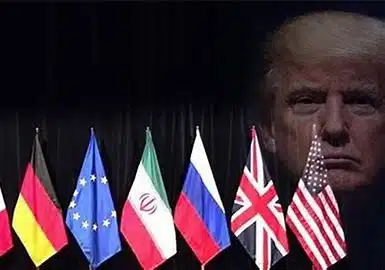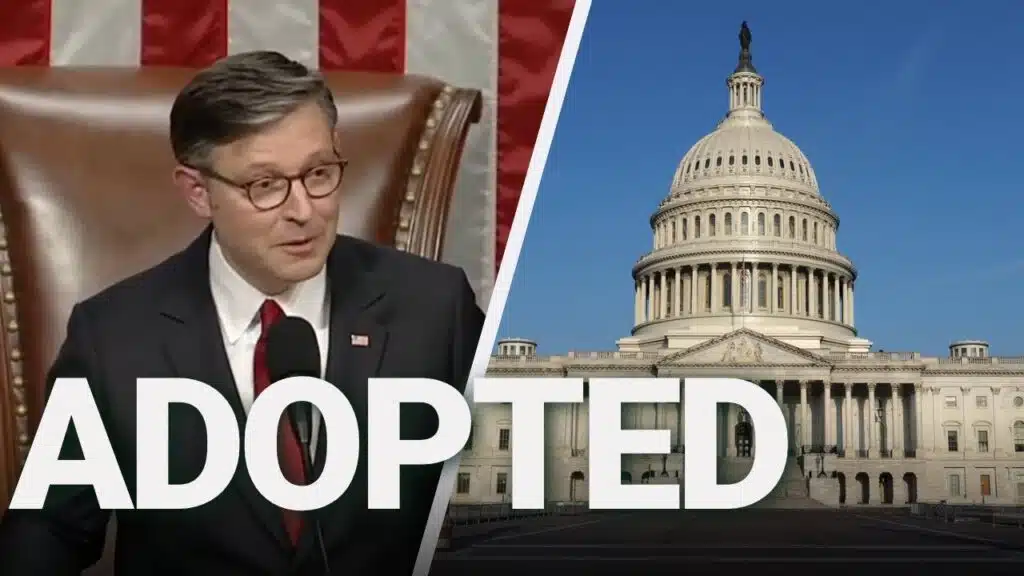
Like Russia, North Korea Must Remain a Permanent Enemy
With Vladimir Putin saber rattling his arsenal of almost 6000 nuclear warheads, the ranting of Kim Jong-un, with his measly 50 nuclear weapons, just doesn’t arouse the same level of terror as it did in the early to mid-2010s. As such, Kim has kind of slipped under the radar a bit as cognitively failing Joe Biden pushes us ever closer to the brink of nuclear Armageddon through his proxy war in Ukraine.
Still, it would be a mistake to dismiss the threat Kim poses to South Korea, Japan and even the continental United States as his nuclear arsenal continues to grow larger and more sophisticated. As Kim ratchets up the aggressive rhetoric, it’s surprising that no one in the media or politics seem to be particularly interested in how we returned to an environment of hostility when relations with North Korea seemed so promising just a few years ago.
I was reminded of this as I read a recent truth from President Trump on Truth Social:

The Brilliance of Trump in Dealing with Kim
Let’s remember that prior to Trump taking office, Kim was threatening the U.S. on an almost daily basis, and since relations with Russia and China were relatively friendly at the time, North Korea was a focal point of foreign policy and media coverage.
In 2011, when Kim took over the position of Supreme Leader from his recently deceased father, Kim Jong-il, the world naively hoped the younger Kim might be more benevolent than his father and grandfather. However, Kim followed the family blueprint for consolidating power by executing his adversaries and attaining unwavering allegiance from the citizenry through intimidation.
According to the Commission of Inquiry on Human Rights in the Democratic People’s Republic of Korea, Kim galvanized his control through “extermination, murder, enslavement, torture, imprisonment, rape, forced abortions, sexual violence, persecution on political, religious, racial and gender grounds, forcible transfer of populations, enforced disappearance of persons and the inhumane act of knowingly causing prolonged starvation.”
While sending a message to his own people, Kim also followed his father’s foreign policy blueprint, which revolved around the concept of intimidating adversaries through nuclear blackmail. For six years, Kim engaged in provocative threats and actions, including firing missiles over the Sea of Japan, firing artillery shells into the Yellow Sea near the demilitarized zone and testing missiles with increasingly longer range.
The Kim reign of terror seemed to crescendo in 2017 when North Korea test fired its first ICBM, the Hwasong-14, on July 4th in an obvious provocation and snub to the United States. During that period, the bombast between Kim and Trump reached its apex when Kim said, “The entire mainland of the U.S. is within the range of our nuclear weapons, and the nuclear button is always on the desk of my office. They should accurately be aware that this is not a threat but a reality.”
Trump responded almost immediately on social media. “North Korean Leader Kim Jong Un just stated that the ‘Nuclear Button is on his desk at all times.’ Will someone from his depleted and food starved regime please inform him that I too have a Nuclear Button, but it is a much bigger & more powerful one than his, and my Button works!”
Yet, as the world worried that hostilities might spill over into the nuclear arena, something unexpected happened. Kim and Trump came to the negotiating table.
North Korea-U.S. Relations Change Dramatically
To say the sudden change in U.S.-North Korea relations was stunning would be an understatement. Negotiations between the two nations, brokered by Japan and South Korea, resulted in a conference between Kim and Trump, commonly known as the Singapore summit. After the meeting, the two leaders signed an agreement that provided security guarantees for North Korea, recovery of soldier remains, set a goal for the denuclearization of the Korean peninsula and arranged for follow-up meetings between high-level officials.
After the summit, Trump announced that the U.S. would discontinue its “provocative” joint military exercises with South Korea and would start bringing soldiers back home. However, the U.S. Senate, perhaps the most centralized clot of neocon Republicans assembled at one place at one time, passed a military bill expressly forbidding a funding reduction for personnel in South Korea below 22,000.
Hmmm… With tensions deescalating, it makes you wonder why those in the Senate were so adamant about keeping troops in South Korea unnecessarily.
From June 2018 until March 2020, North Korea did not launch a missile, test a warhead, engage or even suggest anything that could be considered provocative or threatening against the United States.
Nothing…
Trump’s Strategic Error with Kim
So, what has changed since President Trump forged a productive and promising relationship with Kim Jong-un?
If Trump made an error in his approach with North Korea, it was his insistence that Kim completely dismantle his nuclear weapons before sanctions would be lifted and the relationship could progress. Gaddafi in Libya was executed after he gave up his weapons of mass destruction. Belarus gave up its nuclear weapons and became a proxy state for Russia. Ukraine gave up its nuclear weapons and now finds itself in a battle for its survival. The reality is that a country with nuclear weapons has a strong bargaining chip, and in light of how leaders of countries that unilaterally disarmed were treated, there was no way Kim was ever going to agree to those terms.
Trump may have understood that reality, but the only way the biased and spiteful U.S. media would give him any credit for the remarkable work he did with North Korea was if Kim totally disarmed. We need to ask ourselves this question: Would friendly relations with a nuclear-armed North Korea be better or worse than hostile relations that resulted in Kim ramping up his weapons development program?
Biden Brings Back Business as Usual
Almost immediately upon taking office, Joe Biden returned to the adversarial policy that remained in place since the end of the Korean war. The joint exercises with South Korea resumed, North Korea started shooting missiles toward Japan, and Kim resumed his talk of nuclear war. Nowhere in the media, or the Republican party for that matter, has this policy change been questioned, except by President Trump.
In fact, earlier this month, Kim’s sister, Kim Yo-jong, said that North Korea would turn the Pacific into a “firing range” as tensions in the Asia-Pacific region further heightened.
This begs the question, who exactly is it that believes this environment of acrimony, tension and fear of nuclear war is better than the peaceful and promising relationship Trump was building with Kim?
You think it might be U.S. defense companies, their lobbyists and friendly politicians in the government?
In 2021, South Korea ranked 10th in the world in defense expenditures at $50.2 billion, and the largest portion of its weapons and parts purchases came from U.S. companies. From 2013-2017, South Korea purchased roughly $13 billion from the U.S. through the Foreign Military Sales (FMS) program and half that much through its Direct Commercial Sales (DCS) program. How do you think Raytheon, General Dynamics, Lockheed Martin and other U.S. defense contractors felt about a de-escalation of tensions on the Korean peninsula and a drawdown of troops as Trump suggested?
Like Russia, where the opportunity of the century for global peace was squandered because NATO needed a Russian enemy to justify its existence, ongoing animosity with North Korea also serves a purpose.
Follow the money. It always leads to the truth. And hey, if you worry about the future of your children in a world saturated with iodine-131 radioactive fallout, just remember, there are a lot of politicians who own defense stocks in their portfolios.



